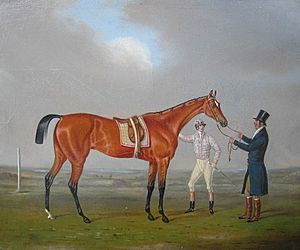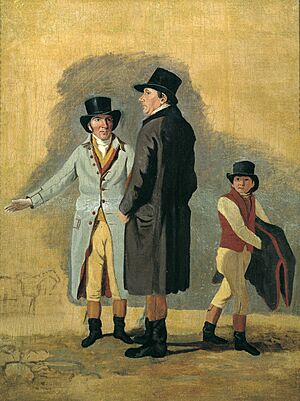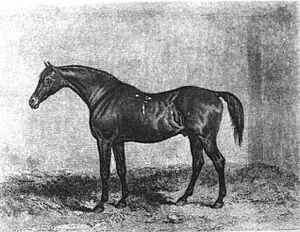Eleanor (horse) facts for kids
Quick facts for kids Eleanor |
|
|---|---|

Eleanor, c. 1801, in a painting by Richard Denew
|
|
| Sire | Whiskey |
| Grandsire | Saltram |
| Dam | Young Giantess |
| Damsire | Diomed |
| Sex | Mare |
| Foaled | 1798 |
| Country | Kingdom of Great Britain |
| Colour | Bay |
| Breeder | Charles Bunbury |
| Owner | 1) Charles Bunbury (1798–1821) 2) Mr. Rush (1822–c.1824) |
| Trainer | Cox or J. Frost |
| Record | 46: 29-8-1 |
| Major wins | |
|
|
Eleanor (born in 1798, died around 1824) was a famous British Thoroughbred racehorse. She was bred by Charles Bunbury. Eleanor made history by becoming the very first female horse to win The Derby.
In 1801, Eleanor also won the Epsom Oaks, another important race. She won many other races too. Eleanor stopped racing when she was eight years old. After her racing career, she became a broodmare for Bunbury. This means she had foals (baby horses).
Eleanor gave birth to a stallion named Muley. Muley later became the father of Marpessa, who was the mother of Pocahontas. Pocahontas is a very important horse in racing history. Eleanor's family line also includes Leviathan, a famous stallion sent to the United States.
Contents
About Eleanor's Early Life
Eleanor was born in 1798 at Barton Hall. This was the home of her breeder, Charles Bunbury. She was a bay filly, which means she had a reddish-brown coat. Eleanor had a small white star on her forehead. She also had a white sock marking on her left back foot.
Eleanor's Parents
Eleanor's father was a horse named Whiskey. Bunbury bought Whiskey in 1793 after his racing days. Whiskey was born in 1789 and was bred by the Prince of Wales. He won several races during his career.
Eleanor's mother was a mare named Young Giantess. She was born in 1790. Young Giantess's father was Diomed, who won the very first Epsom Derby. Diomed was also owned by Charles Bunbury. Young Giantess had a mother named Giantess. Giantess was a successful racehorse before she became a broodmare.
Young Giantess was a fantastic mother horse. She gave birth to many important foals. One of her famous sons was Sorcerer. Eleanor was Young Giantess's third foal. Young Giantess also had seven other foals that were full siblings to Eleanor. This means they had the same mother and father.
Eleanor's Racing Career
Eleanor did not race when she was two years old. She was owned by Charles Bunbury for her entire four-year racing career. She won 29 out of her 48 races, which is a great record! Her trainers were either a man named Cox or J. Frost.
There's a famous story about Eleanor's trainer. On his deathbed, he supposedly told a clergyman, "Depend upon it, that Eleanor is a h—l of a mare!" This shows how amazing people thought she was.
In 1801, when she was three years old, Eleanor made history. She became the first filly (young female horse) to win The Derby. The very next day, she also won the Epsom Oaks. Winning both races in the same year was a huge achievement. This feat was not repeated for 56 years! Only four fillies have ever won both the Epsom Oaks and The Derby. Eleanor's main jockey (the rider) for most of her races was John Saunders. Eleanor stopped racing when she was seven years old. She then returned to Barton Hall to become a broodmare.
1801: Three-Year-Old Season
Eleanor's first race was on April 20 in Newmarket. She won 250 guineas by beating another filly named Miss Fuery. The Epsom Derby was her second race ever, held on May 21. She won against nine colts (young male horses) and one other filly.
The day after winning the Derby, Eleanor won the 550-guinea Epsom Oaks. She beat five other horses in that race. At Ascot, she came in second place. She carried more weight than other horses as a handicap for her big wins. Later that year, Eleanor won a 700-guinea match race against Miss Fuery. She also beat a colt named Flambeau in another match race.
1802: Four-Year-Old Season
Eleanor's first race as a four-year-old was in spring 1802 at Newmarket. She finished last in that race. However, she soon got back to her winning ways. At the First October meeting in Newmarket, she beat the mare Penelope. She won 350 guineas in that race. A few days later, she won the King's Plate. In her last race of the season, Eleanor won £50.
1803: Five-Year-Old Season
In 1803, Eleanor continued to race. She won £50 in a two-mile race at Ipswich. At Oxford, she won The Cup by beating her own sister, Julia. She also won two £50 races at Huntingdon. Eleanor won the King's Plate at Lincoln. She raced several more times that year but did not place in her last two starts.
1804: Six-Year-Old Season
Eleanor had a busy year in 1804. She finished second in the King's Plate at Newmarket. A few days later, she won the Subscription Handicap Plate of £50. She also won the £50 Town Plate at Ipswich. Eleanor won a £50 race at the July Meeting at Newmarket. She won several match races against other horses. At Bedford, she won £20 by being the only horse entered in a race, which is called a "walk over". Eleanor won an 80-guinea gold cup at Newmarket. She also beat Orville in a 375-guinea race.
1805: Seven-Year-Old Season
In her final year of racing, Eleanor won three races at the Egham meeting. She won The Cup, a £50 race, and a 100-guinea race. At the First October meeting at Newmarket, she beat a colt named Czar Peter. She finished second in two gold cup races later that year. Eleanor did not place in the last three races of her career.
Eleanor's Reproduction and Legacy
Eleanor retired from racing in 1806. She became a broodmare at Bunbury's Barton Hall. Charles Bunbury passed away in 1821. All his horses were sold in 1822. Eleanor was sold for just over £91. She likely died in 1823 or 1824.
Eleanor's Foals
Eleanor had ten foals between 1807 and 1823. Her most famous son was a colt named Muley. While many of Eleanor's foals were not top racehorses themselves, Muley and some of her daughters became important parents of future racehorses.
Here are some of her notable foals:
- Nell (1807): A bay filly.
- Muley (1810): A bay colt. Muley raced for only one year but became a very successful father horse. He produced many good racers. His daughter Marpessa gave birth to Pocahontas, who is a key horse in Thoroughbred history. Muley also produced Leviathan, who became a leading father horse in the United States.
- Troilus (1811): A bay colt.
- Bay filly (1814): This mare was important because her foal, Picton, was a successful racehorse. Her 1820 foal, Luzborough, also became a significant father horse in the United States.
- Active (1820): A bay filly. Active's granddaughter, Heads or Tails, was sent to the United States. Heads or Tails became a very important mother horse in America. She is in the family tree of Woodburn, a horse important for the Standardbred breed (trotting horses).
- Aunt Anne (1823): A bay filly. She was later sold to the Swedish government.
Eleanor's Family Tree
| Sire Whiskey Bay 1789 |
Saltram 1780 |
Eclipse | Marske |
|---|---|---|---|
| Spilletta | |||
| Virago | Snap | ||
| Regulus Mare | |||
| Calash 1775 |
Herod* | Tartar | |
| Cypron | |||
| Teresa | Matchem* | ||
| Brown Regulus | |||
| Dam Young Giantess Bay 1790 |
Diomed 1777 |
Florizel | Herod* |
| Cygnet Mare | |||
| Sister to Juno | Spectator | ||
| Horatia | |||
| Giantess 1769 |
Matchem* | Cade | |
| Sister to Miss Partner | |||
| Molly Longlegs | Babraham | ||
| Foxhunter Mare |
* Eleanor has inbreeding to the stallion Herod. This means Herod appears on both her father's and mother's side of the family tree.
* Eleanor also has inbreeding to the stallion Matchem. This means Matchem appears on both her father's and mother's side of the family tree.



